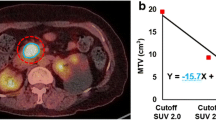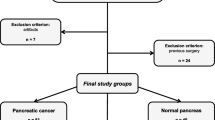Abstract
Purpose
We aimed to analyze the change of quantitative intra-tumoral metabolic heterogeneity consisting of texture features and conventional metabolic parameters of pancreatic cancer (PC) in dual-time 2-deoxy-2(18F) fluoro-d-glucose (18F-FDG) positron emission tomography-computed tomography (PET/CT).
Methods
A retrospective analysis was conducted considering the texture features and conventional metabolic parameters in dual-time 18F-FDG PET/CT scans of PC patients. Features were extracted based on spatial distribution of 18F-FDG uptake in image. Firstly, the texture features and the conventional metabolic parameters of the delayed scan were both compared with that of the early scan. Statistically different data was defined among them. Secondly, the study evaluated the correlations between retention index (RI) of the texture features and the conventional metabolic parameters. Finally, the variation of texture features in dual-time PET/CT of resectable PC patients and unresectable PC patients was calculated separately.
Results
In total, 183 PC patients were analyzed retrospectively in this research. The conventional metabolic parameters were all statistically different between the early and delayed scans except for metabolic tumor volume (MTV). In the radiomics, there were 59 textural features. Nineteen of 59 texture features were statistically different between the early and delayed scans. Features that were more than 10% different during two scans were observed in a substantial percentage of patients. Weak correlations were only found between MTV, TLG (Total lesion glycolysis), SUVpeak and the RI of some texture features in early or delayed scans. There were obviously fewer features with significant difference in resectable PC group than in unresectable PC group. Most features showing the difference in unresectable group while no significant difference in resectable group.
Conclusions
This study investigated the change and inner correlations of quantitative tumoral metabolic heterogeneity in the dual-time 18F-FDG-PET/CT scan of PC patients. Some features displayed the difference between dual-time scans. Conventional metabolic parameters were weakly related to the change of texture feature. The change of texture feature in resectable PC group was different from that in unresectable PC group. This result is potential to provide more information for the image evaluation of PC.
Similar content being viewed by others
Data availability
The authors confirm that the data supporting this study are available within the article and its supplementary materials.
References
Siegel RL, Miller KD (2016) Jemal A (2016) Cancer statistics. CA Cancer J Clin 66(1):7–30. https://doi.org/10.3322/caac.21332
Zhang Z, Song J, Xie C, et al. (2021) Pancreatic Cancer: Recent Progress of Drugs in Clinical Trials. AAPS J 23(2):29. https://doi.org/10.1208/s12248-021-00556-2
Khanal N, Upadhyay S, Dahal S, Bhatt VR, Silberstein PT (2015) Systemic therapy in stage IV pancreatic cancer: a population-based analysis using the National Cancer Data Base. Ther Adv Med Oncol 7(4):198–205
Lepanto L, Arzoumanian Y, Gianfelice D, et al. (2002) Helical CT with CT angiography in assessing periampullary neoplasms: identification of vascular invasion. Radiology 222(2):347–352. https://doi.org/10.1148/radiol.2222010203
Manak E, Merkel S, Klein P, et al. (2009) Resectability of pancreatic adenocarcinoma: assessment using multidetector-row computed tomography with multiplanar reformations. Abdom Imaging 34(1):75–80. https://doi.org/10.1007/s00261-007-9285-2
Pawlik TM, Laheru D, Hruban RH, et al. (2008) Evaluating the impact of a single-day multidisciplinary clinic on the management of pancreatic cancer. Ann Surg Oncol 15(8):2081–2088. https://doi.org/10.1245/s10434-008-9929-7
Rhee H, Park MS (2021) The Role of Imaging in Current Treatment Strategies for Pancreatic Adenocarcinoma. Korean J Radiol 22(1):23–40
Raman SP, Horton KM, Fishman EK (2012) Multimodality imaging of pancreatic cancer-computed tomography, magnetic resonance imaging, and positron emission tomography. Cancer journal (Sudbury, Mass) 18(6):511–522. https://doi.org/10.1097/PPO.0b013e318274a461
Motosugi U, Ichikawa T, Morisaka H, et al. (2011) Detection of pancreatic carcinoma and liver metastases with gadoxetic acid-enhanced MR imaging: comparison with contrast-enhanced multi-detector row CT. Radiology 260(2):446–453. https://doi.org/10.1148/radiol.11103548
Cameron K, Golan S, Simpson W, et al. (2011) Recurrent pancreatic carcinoma and cholangiocarcinoma: 18F-fluorodeoxyglucose positron emission tomography/computed tomography (PET/CT). Abdom Imaging 36(4):463–471. https://doi.org/10.1007/s00261-011-9729-6
Kuwatani M, Kawakami H, Eto K, et al. (2009) Modalities for evaluating chemotherapeutic efficacy and survival time in patients with advanced pancreatic cancer: comparison between FDG-PET, CT, and serum tumor markers. Intern Med 48(11):867–875. https://doi.org/10.2169/internalmedicine.48.2009
Pakzad F, Groves AM, Ell PJ (2006) The role of positron emission tomography in the management of pancreatic cancer. Semin Nucl Med 36(3):248–256. https://doi.org/10.1053/j.semnuclmed.2006.03.005
Choi HJ, Lee JW, Kang B, et al. (2014) Prognostic significance of volume-based FDG PET/CT parameters in patients with locally advanced pancreatic cancer treated with chemoradiation therapy. Yonsei Med J 55(6):1498–1506. https://doi.org/10.3349/ymj.2014.55.6.1498
Kim HS, Choi JY, Choi DW, et al. (2014) Prognostic Value of Volume-Based Metabolic Parameters Measured by (18)F-FDG PET/CT of Pancreatic Neuroendocrine Tumors. Nucl Med Mol Imaging 48(3):180–186. https://doi.org/10.1007/s13139-013-0262-0
Zhuang H, Pourdehnad M, Lambright ES, et al. (2001) Dual time point 18F-FDG PET imaging for differentiating malignant from inflammatory processes. Journal of nuclear medicine : official publication, Society of Nuclear Medicine 42(9):1412–1417
Kawada N, Uehara H, Hosoki T, et al. (2015) Usefulness of dual-phase 18F-FDG PET/CT for diagnosing small pancreatic tumors. Pancreas 44(4):655–659. https://doi.org/10.1097/mpa.0000000000000313
Chicklore S, Goh V, Siddique M, et al. (2013) Quantifying tumour heterogeneity in 18F-FDG PET/CT imaging by texture analysis. Eur J Nucl Med Mol Imaging 40(1):133–140. https://doi.org/10.1007/s00259-012-2247-0
Davnall F, Yip CS, Ljungqvist G, et al. (2012) Assessment of tumor heterogeneity: an emerging imaging tool for clinical practice? Insights Imaging 3(6):573–589
Nakamoto Y, Saga T, Higashi T, et al. (2003) Optimal scan time for evaluating pancreatic disease with positron emission tomography using F-18-fluorodeoxyglucose. Annals of nuclear medicine 17(5):421–426. https://doi.org/10.1007/bf03006614
O’Connor JP, Rose CJ, Waterton JC, et al. (2015) Imaging intratumor heterogeneity: role in therapy response, resistance, and clinical outcome. Clin Cancer Res 21(2):249–257
Weber WA, Schwaiger M, Avril N (2000) Quantitative assessment of tumor metabolism using FDG-PET imaging. Nucl Med Biol 27(7):683–687. https://doi.org/10.1016/s0969-8051(00)00141-4
Willaime JM, Turkheimer FE, Kenny LM, Aboagye EO (2013) Quantification of intra-tumour cell proliferation heterogeneity using imaging descriptors of 18F fluorothymidine-positron emission tomography. Phys Med Biol 58(2):187–203. https://doi.org/10.1088/0031-9155/58/2/187
Visvikis D, Hatt M, Tixier F, Cheze Le Rest C (2012) The age of reason for FDG PET image-derived indices. Eur J Nucl Med Mol Imaging 39(11):1670–1672. https://doi.org/10.1007/s00259-012-2239-0
Basu S, Kwee TC, Gatenby R, et al. (2011) Evolving role of molecular imaging with PET in detecting and characterizing heterogeneity of cancer tissue at the primary and metastatic sites, a plausible explanation for failed attempts to cure malignant disorders. Eur J Nucl Med Mol Imaging 38(6):987–991. https://doi.org/10.1007/s00259-011-1787-z
Michallek F, Dewey M (2014) Fractal analysis in radiological and nuclear medicine perfusion imaging: a systematic review. Eur Radiol 24(1):60–69. https://doi.org/10.1007/s00330-013-2977-9
van Velden FH, Cheebsumon P, Yaqub M, et al. (2011) Evaluation of a cumulative SUV-volume histogram method for parameterizing heterogeneous intratumoural FDG uptake in non-small cell lung cancer PET studies. Eur J Nucl Med Mol Imaging 38(9):1636–1647
Mena E, Sheikhbahaei S, Taghipour M, et al. (2017) 18F-FDG PET/CT Metabolic Tumor Volume and Intratumoral Heterogeneity in Pancreatic Adenocarcinomas: Impact of Dual-Time Point and Segmentation Methods. Clin Nucl Med 42(1):e16–e21. https://doi.org/10.1097/RLU.0000000000001446
Hatt M, Tixier F, Pierce L, et al. (2017) Characterization of PET/CT images using texture analysis: the past, the present… any future? Eur J Nucl Med Mol Imaging 44(1):151–165. https://doi.org/10.1007/s00259-016-3427-0
Belli ML, Mori M, Broggi S, et al. (2018) Quantifying the robustness of [(18)F]FDG-PET/CT radiomic features with respect to tumor delineation in head and neck and pancreatic cancer patients. Phys Med 49:105–111. https://doi.org/10.1016/j.ejmp.2018.05.013
Santhosh S, Mittal BR, Bhasin D, et al. (2014) Dual-phase 18F-FDG PET/CT imaging in the characterization of pancreatic lesions: does it offer prognostic information? Nucl Med Commun 35(10):1018–1025. https://doi.org/10.1097/MNM.0000000000000157
Piñeiro-Fiel M, Moscoso A, Lado-Cacheiro L, et al. (2020) Is FDG-PET texture analysis related to intratumor biological heterogeneity in lung cancer? Eur Radiol. https://doi.org/10.1007/s00330-020-07507-z
Yoo MY, Yoon YS, Suh MS, et al. (2020) Prognosis prediction of pancreatic cancer after curative intent surgery using imaging parameters derived from F-18 fluorodeoxyglucose positron emission tomography/computed tomography. Medicine (Baltimore) 99(35):e21829
Funding
The work was supported by the project of Shanghai municipal health commission (No. 201840082).
Author information
Authors and Affiliations
Corresponding authors
Ethics declarations
Conflict of interest
The authors declare that they have no conflict of interest.
Consent to participate
Waived by the ethics committee of Shanghai Changhai Hospital.
Consent for publication
Approved.
Ethical approval
The retrospective study was approved by the ethics committee of Shanghai Changhai Hospital and registered with the number of CHEC2019-089.
Additional information
Publisher's Note
Springer Nature remains neutral with regard to jurisdictional claims in published maps and institutional affiliations.
Guorong Jia and Jian Zhang contributed equally to this article.
Supplementary Information
Below is the link to the electronic supplementary material.
Rights and permissions
About this article
Cite this article
Jia, G., Zhang, J., Li, R. et al. The exploration of quantitative intra-tumoral metabolic heterogeneity in dual-time 18F-FDG PET/CT of pancreatic cancer. Abdom Radiol 46, 4218–4225 (2021). https://doi.org/10.1007/s00261-021-03068-x
Received:
Revised:
Accepted:
Published:
Issue Date:
DOI: https://doi.org/10.1007/s00261-021-03068-x




